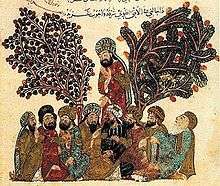Maqamat Badi' az-Zaman al-Hamadhani
| Part of a series on |
| Arab culture |
|---|

Maqamat Badi' al-Zaman al-Hamadhani
Maqamat Badi' al-Zaman al-Hamadhani (Arabic مقامات بديع الزمان الهمذاني), are an Arabic collection from the 9th century of 400 episodic stories, roughly 52 of which have survived. They 'are characterized by the alternation of rhymed prose (sajʿ) and poetry.[1] They are narrated from the point of view of a fictitious character, 'very likely a traveling merchant who has money and time', ʿĪsā ibn Hishām, about the adventures of an eloquent beggar named Abū al-Fatḥ al-Iskandarī'.[2] The Maqamat are also known for their intertextuality and narrative construction.[3]
According to Ailin Qian,
the core of the Hamadhānian maqāmah is dialogue, and al-Hamadhānī, by using techniques such as isnād and framing, simulated some kind of public presentation. Al-Hamadhānī’s efforts to preserve the characteristics of oral performance in his maqāmāt## played a great role in creating their prosimetric style.[4]
A century later, these maqamat inspired the maqamat of Al-Hariri of Basra, which in turn inspired the Hebrew Tahkemoni.
Editions and translations
- The Maqámát of Badí‘ al-Zamán al-Hamadhání The original version In Arabic (Wikisource)
- Al-Hamadhānī, Badīʿ al-zamān. Dīwān. Edited by ʿAbd al-Wahhāb Raḍwān and Muḥammad Shukrī Afandī al-Makkī. Cairo: Maṭbaʿat al-mawsūʿāt, 1903.
- Al-Hamadhānī, Badīʿ al-zamān. Maqāmāt. Edited by Fārūq Saʿd. Beirut: Dār al-āfāq al-jadīdah, 1982.
- Al-Hamadhānī, Badīʿ al-zamān. Maqāmāt Abī al-Faḍl Badīʿ al-zamān al-Hamadhānī. Edited by Muḥammad ʿAbduh. Beirut: Dār al-Mashriq, 1973.
- W. J. Prendergast (trans.), The Maqāmāt of Badīʿ al-Zamān al-Hamadhānī (London: Curzon Press, 1973 [repr.]), http://www.sacred-texts.com/isl/mhm/index.htm
See also
References
- ↑ Ailin Qian, "The maqāmah as prosimetrum: A comparative investigation of its origin, form and function" (Unpublished PhD thesis, University of Pennsylvania, 2012), http://repository.upenn.edu/dissertations/AAI3509392, p. 2.
- ↑ Ailin Qian, "The maqāmah as prosimetrum: A comparative investigation of its origin, form and function" (Unpublished PhD thesis, University of Pennsylvania, 2012), http://repository.upenn.edu/dissertations/AAI3509392, p. 36.
- ↑ ""There is a Jahiz for every age": Narrative construction and intertxtuality in la-Hamdhani's maqamat". www.academia.edu. Retrieved 2016-03-23.
- ↑ Ailin Qian, "The maqāmah as prosimetrum: A comparative investigation of its origin, form and function" (Unpublished PhD thesis, University of Pennsylvania, 2012), http://repository.upenn.edu/dissertations/AAI3509392, p. 34.
This article is issued from Wikipedia - version of the 4/16/2016. The text is available under the Creative Commons Attribution/Share Alike but additional terms may apply for the media files.